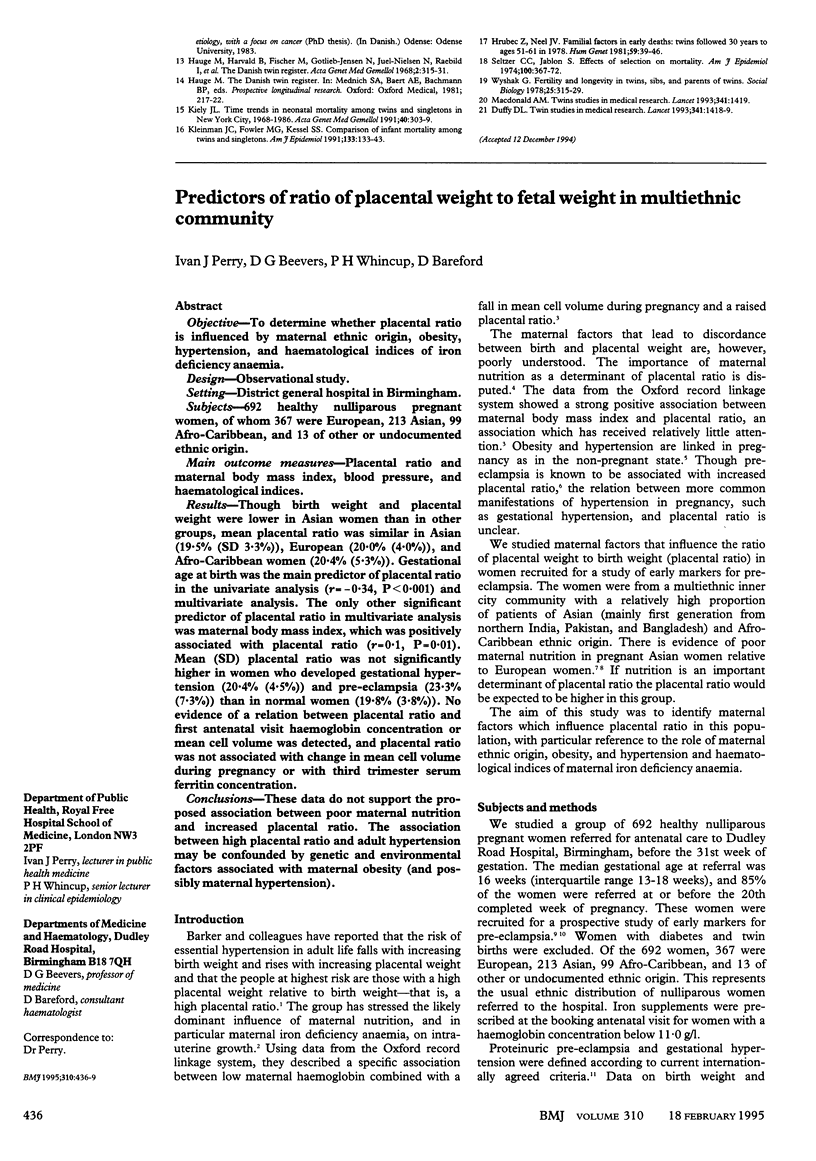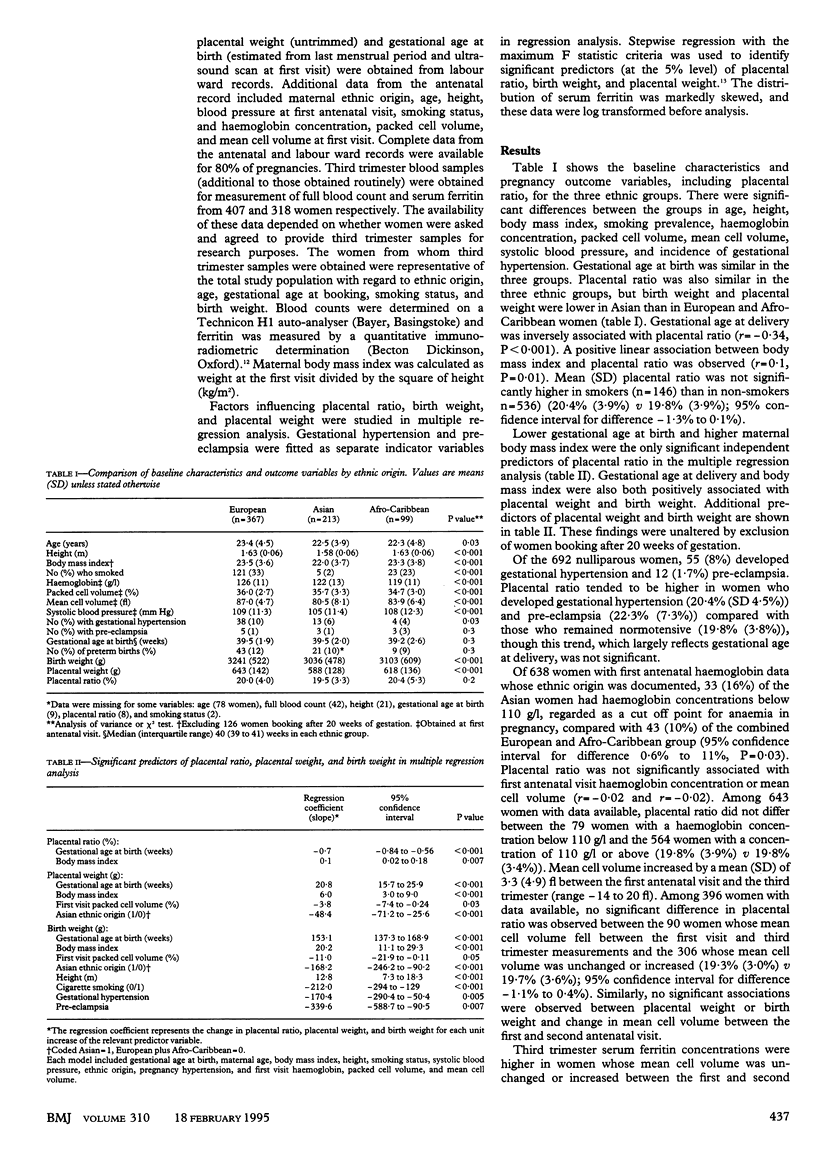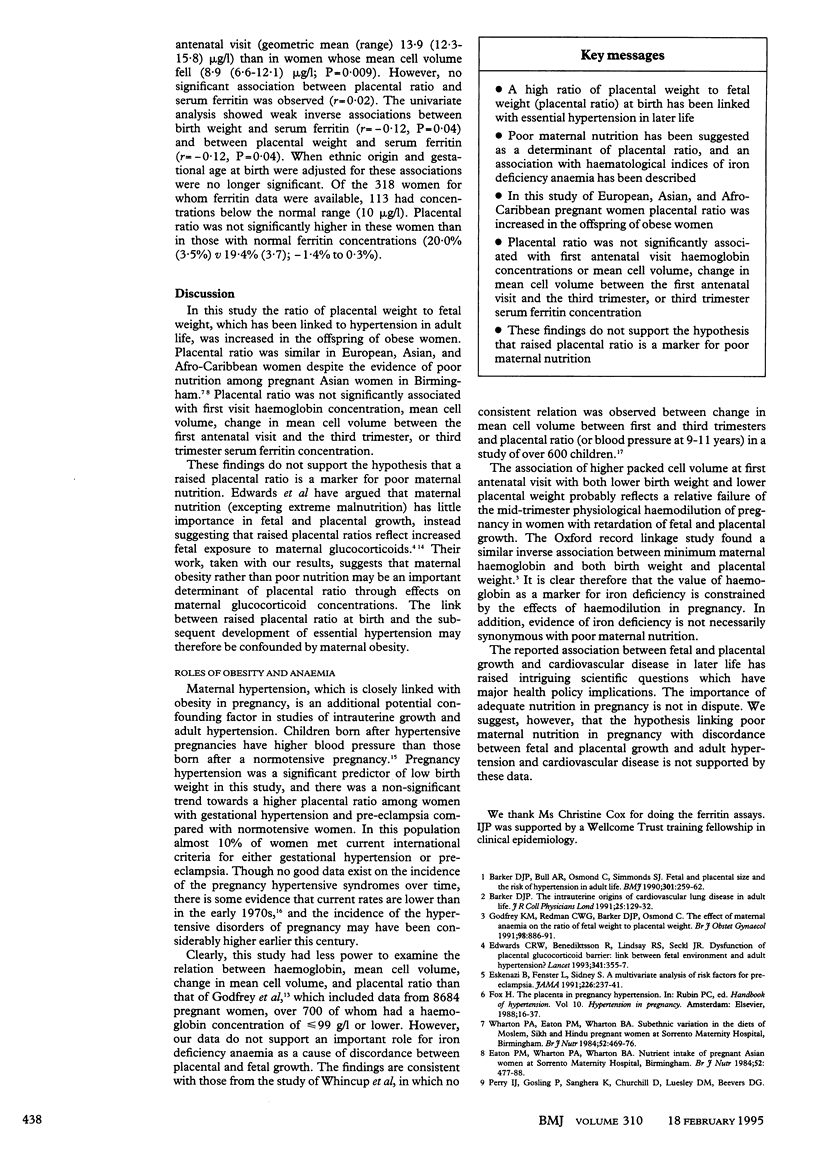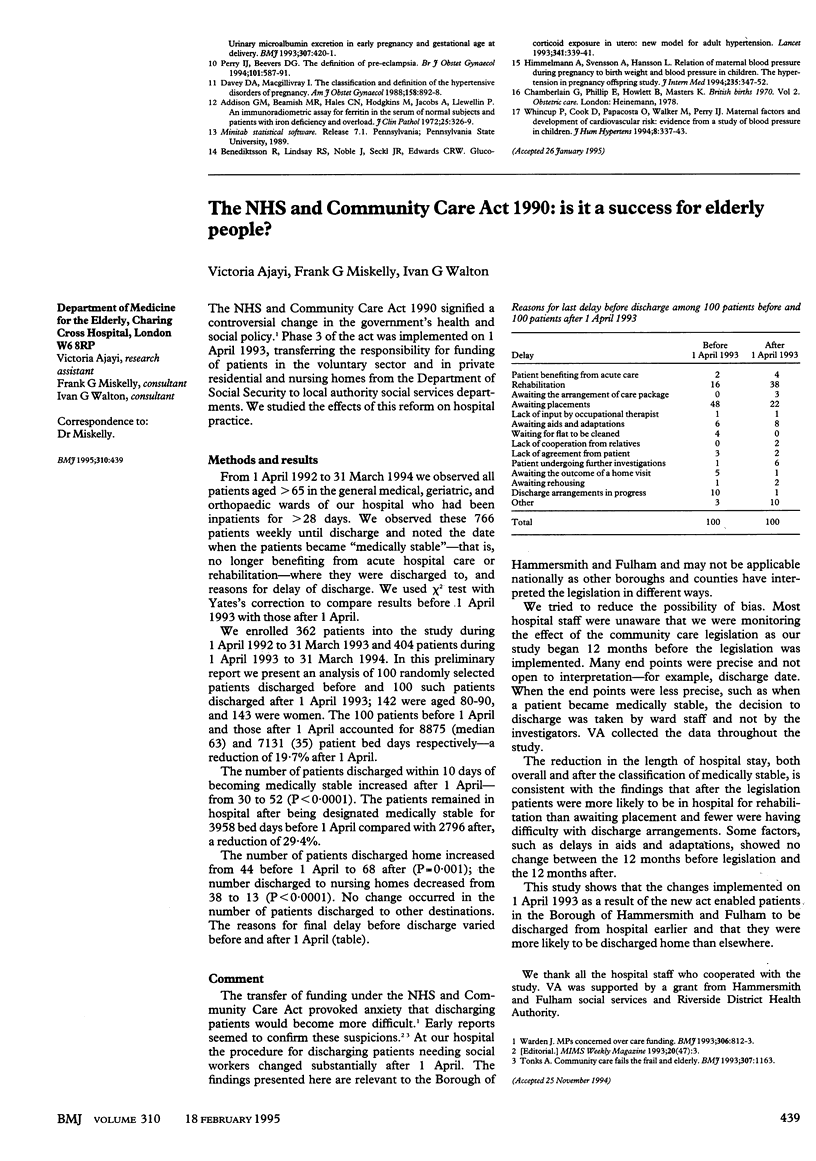Abstract
OBJECTIVE--To determine whether placental ratio is influenced by maternal ethnic origin, obesity, hypertension, and haematological indices of iron deficiency anaemia. DESIGN--Observational study. SETTING--District general hospital in Birmingham. SUBJECTS--692 healthy nulliparous pregnant women, of whom 367 were European, 213 Asian, 99 Afro-Caribbean, and 13 of other or undocumented ethnic origin. MAIN OUTCOME MEASURES--Placental ratio and maternal body mass index, blood pressure, and haematological indices. RESULTS--Though birth weight and placental weight were lower in Asian women than in other groups, mean placental ratio was similar in Asian (19.5% (SD 3.3%)), European (20.0% (4.0%)), and Afro-Caribbean women (20.4% (5.3%)). Gestational age at birth was the main predictor of placental ratio in the univariate analysis (r = -0.34, P < 0.001) and multivariate analysis. The only other significant predictor of placental ratio in multivariate analysis was maternal body mass index, which was positively associated with placental ratio (r = 0.1, P = 0.01). Mean (SD) placental ratio was not significantly higher in women who developed gestational hypertension (20.4% (4.5%)) and pre-eclampsia (23.3% (7.3%)) than in normal women (19.8% (3.8%)). No evidence of a relation between placental ratio and first antenatal visit haemoglobin concentration or mean cell volume was detected, and placental ratio was not associated with change in mean cell volume during pregnancy or with third trimester serum ferritin concentration. CONCLUSIONS--These data do not support the proposed association between poor maternal nutrition and increased placental ratio. The association between high placental ratio and adult hypertension may be confounded by genetic and environmental factors associated with maternal obesity (and possibly maternal hypertension).
Full text
PDF



Selected References
These references are in PubMed. This may not be the complete list of references from this article.
- Addison G. M., Beamish M. R., Hales C. N., Hodgkins M., Jacobs A., Llewellin P. An immunoradiometric assay for ferritin in the serum of normal subjects and patients with iron deficiency and iron overload. J Clin Pathol. 1972 Apr;25(4):326–329. doi: 10.1136/jcp.25.4.326. [DOI] [PMC free article] [PubMed] [Google Scholar]
- Barker D. J., Bull A. R., Osmond C., Simmonds S. J. Fetal and placental size and risk of hypertension in adult life. BMJ. 1990 Aug 4;301(6746):259–262. doi: 10.1136/bmj.301.6746.259. [DOI] [PMC free article] [PubMed] [Google Scholar]
- Barker D. J. The intrauterine origins of cardiovascular and obstructive lung disease in adult life. The Marc Daniels Lecture 1990. J R Coll Physicians Lond. 1991 Apr;25(2):129–133. [PMC free article] [PubMed] [Google Scholar]
- Benediktsson R., Lindsay R. S., Noble J., Seckl J. R., Edwards C. R. Glucocorticoid exposure in utero: new model for adult hypertension. Lancet. 1993 Feb 6;341(8841):339–341. doi: 10.1016/0140-6736(93)90138-7. [DOI] [PubMed] [Google Scholar]
- Davey D. A., MacGillivray I. The classification and definition of the hypertensive disorders of pregnancy. Am J Obstet Gynecol. 1988 Apr;158(4):892–898. doi: 10.1016/0002-9378(88)90090-7. [DOI] [PubMed] [Google Scholar]
- Edwards C. R., Benediktsson R., Lindsay R. S., Seckl J. R. Dysfunction of placental glucocorticoid barrier: link between fetal environment and adult hypertension? Lancet. 1993 Feb 6;341(8841):355–357. doi: 10.1016/0140-6736(93)90148-a. [DOI] [PubMed] [Google Scholar]
- Eskenazi B., Fenster L., Sidney S. A multivariate analysis of risk factors for preeclampsia. JAMA. 1991 Jul 10;266(2):237–241. [PubMed] [Google Scholar]
- Himmelmann A., Svensson A., Hansson L. Relation of maternal blood pressure during pregnancy to birth weight and blood pressure in children. The Hypertension in Pregnancy Offspring Study. J Intern Med. 1994 Apr;235(4):347–352. doi: 10.1111/j.1365-2796.1994.tb01085.x. [DOI] [PubMed] [Google Scholar]
- Johnson I. T., Gee J. M., Mahoney R. R. Effect of dietary supplements of guar gum and cellulose on intestinal cell proliferation, enzyme levels and sugar transport in the rat. Br J Nutr. 1984 Nov;52(3):477–487. doi: 10.1079/bjn19840115. [DOI] [PubMed] [Google Scholar]
- Perry I. J., Beevers D. G. The definition of pre-eclampsia. Br J Obstet Gynaecol. 1994 Jul;101(7):587–591. doi: 10.1111/j.1471-0528.1994.tb13648.x. [DOI] [PubMed] [Google Scholar]
- Perry I. J., Beevers D. G., Whincup P. H., Bareford D. Predictors of ratio of placental weight to fetal weight in multiethnic community. BMJ. 1995 Feb 18;310(6977):436–439. doi: 10.1136/bmj.310.6977.436. [DOI] [PMC free article] [PubMed] [Google Scholar]
- Perry I. J., Gosling P., Sanghera K., Churchill D., Luesley D. M., Beevers D. G. Urinary microalbumin excretion in early pregnancy and gestational age at delivery. BMJ. 1993 Aug 14;307(6901):420–421. doi: 10.1136/bmj.307.6901.420. [DOI] [PMC free article] [PubMed] [Google Scholar]
- Wharton P. A., Eaton P. M., Wharton B. A. Subethnic variation in the diets of Moslem, Sikh and Hindu pregnant women at Sorrento Maternity Hospital, Birmingham. Br J Nutr. 1984 Nov;52(3):469–476. doi: 10.1079/bjn19840114. [DOI] [PubMed] [Google Scholar]
- Whincup P., Cook D., Papacosta O., Walker M., Perry I. Maternal factors and development of cardiovascular risk: evidence from a study of blood pressure in children. J Hum Hypertens. 1994 May;8(5):337–343. [PubMed] [Google Scholar]


